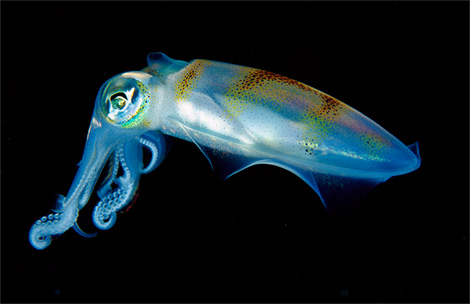Wednesday, April 6, 2011
April 6, 2011 : Opalescent Squid
Opalescent Squid
The Opalescent Inshore Squid (Loligo opalescens) is a small squid (mantle length (ML) up to 190 mm) in the family Loliginidae. It is a myopsid squid, which is the near shore group and that means that they have corneas over their eyes. The species lives in the Eastern Pacific Ocean from Mexico's Baja California peninsula to Alaska, USA, within 200 miles (320 kilometers) off shore.
Adult Loligo opalescens can reach a total size of 28 cm. Males are typically larger with a mantle length of 13-19 cm, while females are 12-18 cm in mantle length. The mantle of L. opalescens is not fused to the head and its body is 4 to 5 times longer than it is wide, with fins equal in both length and width. This squid has 8 arms with 2 longer tentacles ending in tentacular clubs equipped with suckers at their ends. The tentacular clubs are narrow with 4 rows of suckers and 2 large rows in the center of the tentacular club bordered by outer rows of smaller suckers. The 8 arms have only 2 rows of alternating suckers running down their length. In male L. opalescens, the left ventral arm is specialized or “hectocotylized” for spermatophore transfer during mating. The eyes of L. opalescens are covered with a non-perforated membrane known as a cornea which is a signature of myopsid squid. The color of L. opalescens can range from white to brown, with the animals able to change their color shades using chromatophores depending on mood and for camouflage. They are normally a bluish-white to mottled brown and gold, and they change to dark red or brown when excited, frightened or feeding.
L. opalescens is a cannibalistic predator that feeds on smaller prey species such as fish, crabs and shrimp, mollusks, and other juvenile squid. It uses its two longer tentacles with tentacular clubs on the end to snare and catch its prey. L. opalescens itself is an important food source for many predators like larger fish, sharks, marine mammals, sea birds, and also humans. Its predators include the Common Seal, California Sea Lion, Blue shark, Chinook salmon, Black-throated Diver, and Brandt's Cormorant.
Subscribe to:
Post Comments (Atom)


No comments:
Post a Comment